ORDER
Strigiformes
FAMILY
Strigidae
GENUS & SPECIES
KEY FEATURES
• Does not rely on sound to find prey, as most owls do
• Loose feathering on head gives it a distinctive fluffy appearance
• Unfeathered feet are equipped with sharp scales and talons to catch and hold fish
• Lacks the ear tufts found in most owl species
WHERE IN THE WORLD?
Found along large rivers and tree-lined streams of Africa, from Nigeria across the Congo Basin and central Africa to the Zambezi River and in Ethiopia south to South Africa

The large, orange-colored Pel’s fishing owl becomes especially noisy before breeding; mating pairs engage in distinctive duets that last for several minutes.
HABITAT
Living along the edges of rivers and wetlands, the Pel’s fishing owl resides throughout most of tropical Africa south of the Sahara Desert. It can be found in strips of riverine forests as well as the great tropical forests of the Congo River
This owl thrives amid large, ancient trees, which provide numerous cavities for roosting and nesting as well as long branches extending over the water — a perfect fishing perch. Rarely seen, Pel’s owl is secretive and can go undetected for long periods of time because it only comes out at night. The Pel’s fishing owl spends the majority of its time in trees and rarely descends to the ground, which is why little is known about this mysterious owl’s way of life.
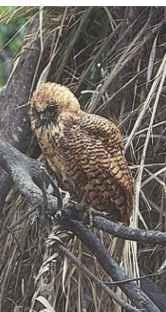
A Tree house The fishing owl sleeps, roosts, nests and hunts in the serenity of the trees throughout its range.
First captured in 1850 in Ghana (then called the Gold Coast), the Pel’s fishing owl was named for that country’s governor, H.S. Pel.
Murky waters force the owl to listen, not watch, for fish movement.
Starvation accounts for most of the deaths of the Pel’s fishing owl, particularly among inexperienced juvenile
“birds, which can’t hunt well.
The Pel’s owl only eats live prey, and always consumes it head first; dead fish are ignored.
FOOD & FEEDING
The Pel’s fishing owl doesn’t rely on the same hunting methods that most owls use. For example, in most owls facial disks around each eye funnel even the slightest sound into the ear openings, which are located just behind the eye. With less prominent disks, the Pel’s owl relies more on sight than sound when hunting for its prey. Also, most owls are stealthy, silent fliers. The Pel’s owl, with its specialized diet of fish, does not need noiseless flight, since fish cannot hear the owl approaching.
Lifecycle
The Pel’s owl perches on large branches that overhang the water, ready to attack. Once t a fish is spotted, the owl swoops down, feet first, and snatches it from the surface of the water with its talons, never plunging into the water: Common ‘ targets include bream, catfish, and barbel. The average catch weighs less than 1 lb.
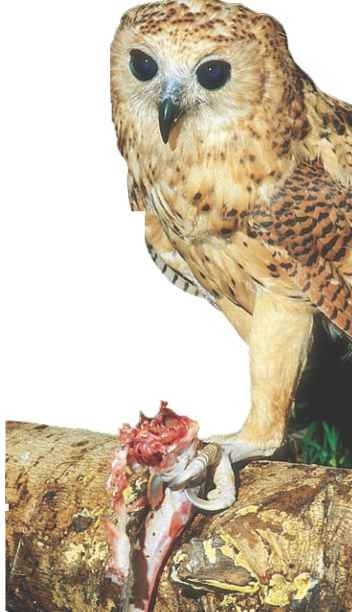
Mighty fisherman This owl is perfectly equipped for landing fish.
BREEDING
The Pel’s fishing owl heralds the breeding season with distinctive melodic duets designed to attract a mate. Once paired, mating begins in the summerto coincide with peak heights of nearby rivers. Chicks are reared as the water levels recede, when fishing conditions are most favorable.The Pel’s fishing owl does not build a nest; the female usually lays her eggs in the hollow of a large tree.
The female incubates the eggs alone for about 35 days, but the male stays close and feeds her as well as the young once they hatch. Although the Pel’s fishing owl lays two eggs, only one chick is reared. The first chick hatches up to five days before the second and bullies its younger sibling until it dies of starvation.The surviving chick fledges in about 70 days, but may stay with its parents longer
During long periods of drought, a mated pair will sometimes let a year or more pass before breeding.
The apprentice The young owl learns to hunt from its parents.
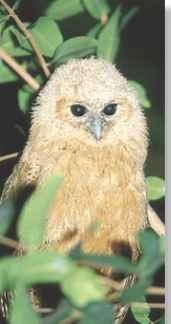
CONSERVATION
The Pel’s fishing owl is rarely seen, and the size of its population is unknown, but experts do not yet consider it to be endangered. It is listed in Appendix II of CITES (Convention on International Trade in Endangered Species). However, the populations of rufous and vermic-ulated fishing owls, the other two African species, are endangered. Habitat destruction is the chief cause.
BEHAVIOR
Being mainly nocturnal, Pel’s fishing owls roost alone or in pairs during the day and emerge around dusk to eat. They have such keen eyesight that they can see the ripples in the water made by fish. The Pel’s owls are extremely territorial, utilizing distinct calls to warn off intruders and defend their turf.
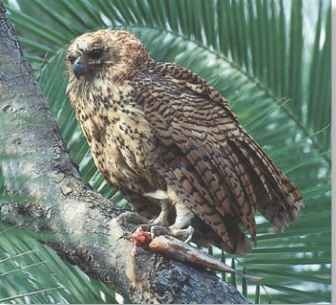
DRIVEN TO DISTRACTION
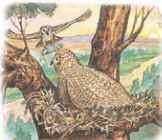
Feeding…
A pair of Pel’s fishing owls nests in an abandoned eagle’s nest.The female incubates the eggs while the male hunts for their food.
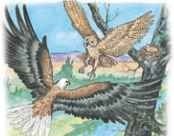
Chasing…
Vigorously defending his family, the male owl chases away an African fish eagle that has come to raid the nest.
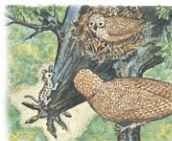
Guarding…
Standing guard near the nest, the male fish owl catches a glimpse of a blotched genet venturing a little too close.

Distracting
The owl dives off the branch into the undergrowth, thrashing about as if injured. Falling for the display, the genet is lured from the nest.
Profile
Pel’s Fishing Owl
One of the largest owls in the world, the uncommonly strong Pel’s fishing owl can subdue a wiggling fish virtually equal to its own weight.
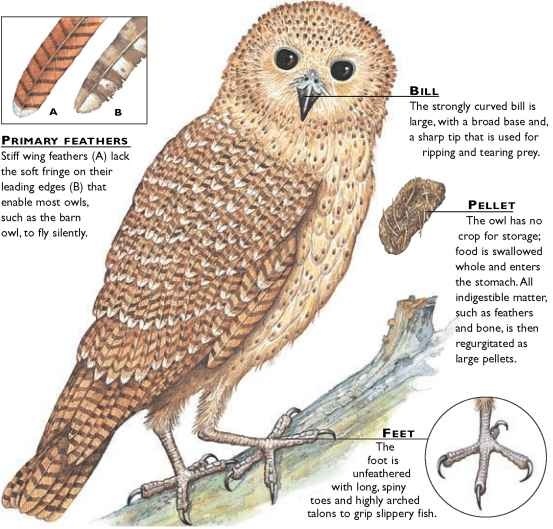
CREATURE COMPARISONS
Most fishing owls have unfeathered legs and feet, but the Blakiston’s fish owl (Ketupa blakistoni) is fully feathered to cope with the cold northerly climates of China and Russia. Inhabiting dense forests bordered by rivers, lakes or the sea, Blakiston’s owl seeks out fast-flowing water that does not freeze in winter. Its plumage is dark brown with wavy horizontal barring, compared to the rufous-orange color of the Pel’s fishing owl.
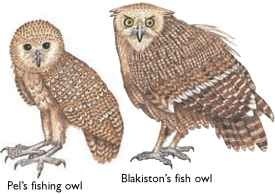
| VITAL STATISTICS Weight 4-5 lbs. |
|
| Length | 20-24″ |
| Wingspan | 4.5-5′ |
| Sexual Maturity | Unknown |
| Breeding Season | February-April |
| Number of Eggs | 2, but only 1 hatchling is reared |
| Incubation Period | About 35 days |
| Fledging Period | About 70 days |
| Breeding Interval | 1 year |
| Typical Diet | Mainly fish; also crabs, frogs and small mammals |
| Lifespan | Unknown |
RELATED SPECIES
• The fishing owls are confined to Africa and Asia, and comprise 7 species in 2 genera. The genus Scotopelia contains all 3 African species: the Pel’s fishing owl; the rufous fishing owl, S. ussheri; and the vermiculated fishing owl, S. bouvieri. The family Strigidae contains about 175 species of raptors that are found in virtually every place in the world.

